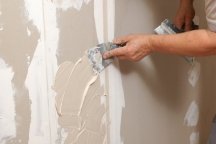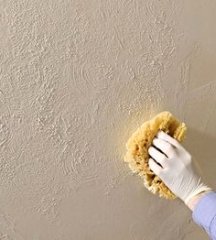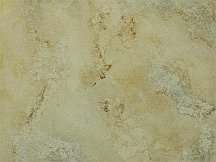Wall Painting Techniques
For Imperfect Walls
Old and damaged walls require special wall painting techniques in order to cover up the surface imperfections - be it loose and cracking plaster or gouged and peeling drywall.
Wall flaws can be a real eyesore, but drywall installation or replacement is not the best or only solution available.
In fact, the right wall painting techniques offer you a faster, cheaper and easier way to handle the problem, and one of the following 3 options will surely work for your situation.
Fix It Up - With Proper Surface Prep
Even if the walls look really bad to you, chances are they can still be restored and made smooth - don't underestimate the power of a good, thorough surface
preparation.

Depending on the extent of the damage (for example, walls with decades of accumulated neglect), some walls may need to be skim coated entirely, to create a new surface.
This is a very labor intensive, multi-step process that requires skill and is better left to professionals if you want really smooth results - armed with some caulk, compound and his tools, an experienced house painting contractor can create what seems like magic and make the surfaces look like new again.
After the repairs and surface prep, follow it up with 2 coats of quality flat paint for a velvet-like finish that will help further blend in any minor imperfections still left, and make them "disappear" (even the slightest hint of sheen in paint will make any flaws more noticeable).
Cover It Up - With Wall Paint Textures
If your walls are really ugly but you are not married to the idea that they must be flat and smooth, using a textured paint may be a better alternative to skim coating (you'll still need to patch up deeply gouged spots first but you won't have to make it perfect).

With textured wall painting techniques, not only can you hide many surface flaws, but you will also add a decorative value to your home at the same time.
And if you've seen some wall texture styles and didn't care much for the look, think again - there are dozens of ways to texture a wall, so no matter what your preferences are, you are bound to find the look you'll like.
Depending on the technique, materials and tools used in the process, you can create a mildly, moderately or heavily textured surface in any color and finish - brushes, wide knifes, wisk brooms, rags, sponges and even your fingers are all great tools to create a unique, one-of-a-kind pattern.
You can also use texture stencils to create raised abstract or theme-based designs on the surface, and some people even use their babies' little hands and feet to leave cute, adorable imprints on the walls!
Play It Up - With Faux Painting Techniques
What if you could use those unsightly wall flaws to your advantage? Well, with decorative wall painting techniques, you can!

With faux painting, you can deliberately highlight and enhance any surface "defects" and turn them into benefits, where they will now look intentional, and play an important part in creating a lived-in, distressed or antique look and feel.
And unless you have some major holes in the walls, you don't even need to do any repairs to the walls, because when incorporated into a faux finish pattern, all the dents, scratches and uneven spots will actually add to the chic and authenticity of the finish.
The best techniques for this purpose are those that use at least 2 colors for an effective play on textures: color-washing, lime-washing, glazing, rubbing and sponging.
See Also:
Painting Rooms to Manipulate the Space
Painting Ceilings to Change Their Height
Decorative Interior Painting Tips for Foyer Walls









Leave a Comment: